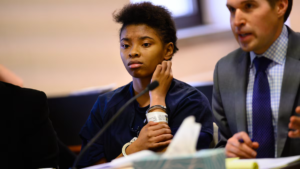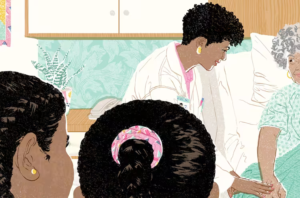The company didn’t set out to build a big library of Black programming, but now it’s the envy of its rivals.
The Black documentarian Stanley Nelson says his phone has been “ringing off the hook” as America is looking again at racism and the Black experience. Justin Simien, the creator of “Dear White People,” says the reactions to his pitches have grown warmer. And the director Ava DuVernay reports a flood of calls to “me and every other Black person that’s ever picked up a camera.”
Hollywood is scrambling, in its traditional way — late, liberal, a bit ham-handed — to catch up with this cultural moment. Some streaming services have made civil rights-themed programming free to all, while studios race to sign new projects by Black directors. And to the immense frustration of mostly white executives all over town, they also find themselves — again! — scrambling to catch up with Netflix, already a threat to their technology and business model, and now winning the race to the center of the conversation as well.
On June 10, Netflix flexed the depth of its Black programming by showcasing a “Black Lives Matter” collection of 56 shows, films and documentaries, including Ms. DuVernay’s mini-series on the false convictions of the Central Park Five, “When They See Us” and her documentary on systemic racism and mass incarceration, “13th.”
“Netflix doesn’t have to trot out the one or two things, but it has a library that’s a wide cross section of taste and content that speaks to the understating of that audience,” said Ms. DuVernay, who is producing a new scripted Netflix series on the former National Football League quarterback Colin Kaepernick. She called the service “the foremost and most robust distributor of Black images in the world.”

Netflix’s chief content officer, Ted Sarandos, and other executives declined to speak on the record to me for this column, perhaps wary of appearing to take credit. They directed me instead to Black creators and their work.
- Thanks for reading The Times.
The story of how the company got there isn’t a particularly satisfying morality tale. It didn’t start with a visionary founder’s decision, a Silicon Valley memo or a culture of promoting Black executives. It is, instead, a recognizable story of stops and starts, internal tensions, corporate competition, social media and personal connections, including to a man known as Hollywood’s “Black Godfather” — all eased by the company’s huge budget for content. But this is a moment when Hollywood, perhaps even more than other media industries, is reckoning with homogeneous leadership — strikingly depicted in “a photo tour through the Leadership/Management pages of the major studios and those of their corporate parents,” published by the iconoclastic newsletter The Ankler. Netflix’s stories offer a glimpse of how the industry is and isn’t changing.
And Netflix isn’t alone in its connection to the moment. HBO’s 2019 series “Watchmen,” a complex treatment of racism in America, has been much discussed in recent months, though the company started its new service HBO Max with more emphasis on mass appeal than cultural relevance. And at Viacom, which has struggled to compete with larger streaming players, I’m told, BET+ has been a bright spot with series including “Ruthless” from the director Tyler Perry.
When Netflix got into original material in 2013, the company didn’t have a particular focus on Black content. But the company also didn’t have to worry about advertisers or weeknight prime-time slots, and its credo was “something for everyone.” The first signal that the service had an opportunity with Black audiences came mostly from the service’s second hit original series, “Orange Is the New Black,” (“House of Cards” was its first) whose breakout characters included the actresses Laverne Cox and Uzo Aduba. The show prompted a wave of discussion at Netflix about how a diverse cast could succeed widely in the United States and globally, and connect, in particular, on social media, where Black voices on Twitter often shape the cultural conversation.
In looking to Black audiences, the young Netflix was following an old pattern in the television business. In the 1990s, Fox and UPNbuilt their networks with shows like “In Living Color” and “Malcolm & Eddie.”
The year after “Orange Is the New Black” became a hit, Netflix began talking to Mr. Simien about turning his film “Dear White People” into a show that would be a pioneer in a now-familiar genre, which Mr. Simien described as “an ensemble of Black articulate millennial activists in a world of white people.” Now, he said, “that’s everywhere,” pointing to “Atlanta,” “Insecure” and “Mixed-ish.” But when he signed with Netflix in 2015, “this show as a whole couldn’t have existed in any other place.”
He attributes the show’s place at Netflix to a Black executive there, Tara Duncan. “It’s the classic thing of — you just have Black people working at your company,” he said. The director Spike Lee voiced a similar sentiment to The Hollywood Reporter in 2017: “At the other places, there were no Black people in the room.”
In reality, Netflix didn’t necessarily have a higher proportion of Black people buying content than other studios. But it had a lot of people buying content, and an unusual approach of distributing the power to make decisions. There were five Black executives who could buy content in 2015, and some of them built relationships with Black directors and producers. One former employee said Black executives were sometimes pulled into meetings with Black directors or actors for show.

In the summer of 2015, Black employees at Netflix produced a memo and PowerPoint presentation to make the case that the company was missing an opportunity with Black audiences. They argued in the documents, which I obtained, that Netflix risked missing a boom defined by “Empire” at Fox and “Black-ish” and “How to Get Away With Murder” on ABC. At the time, the memo estimated, only about two million Black households were subscribing to Netflix — 5 percent of its total subscribers. It said that Black households were a $1.4 billion revenue opportunity and that few of Netflix’s top 100 shows, popular across other groups, were resonating with Black audiences. The memo cited “the (lack of) depth in our Black content catalog,” and said Netflix was spending more money on programming for British people and anime fans than for Black Americans.
They made their arguments to Mr. Sarandos and his team in a conference room full of executives in the second half of 2015, two people who were there said. Crucially, they showed statistics suggesting that licensed Black content was, in the company’s terminology, “efficient,” meaning that it was driving above-average viewership for every dollar spent. (“Scandal” and “The Boondocks” were particularly efficient, while “The Bernie Mac Show” didn’t clear the bar, according to the analysis.) And they raised the question of whether Netflix’s algorithms, in organizing content by race rather than genre, were failing consumers. Mr. Sarandos welcomed the presentation, people present at the time said, though he didn’t take any direct action. One current senior executive said it was taken seriously and influenced buyers across the company.
The Black executives who were buying content during Netflix’s first wave of original programming are all gone now. Some didn’t get promotions. Some were hired away by competitors, and some were burned out by an internal culture officially focused on encouraging freedom and responsibility but whose unsentimental firings and blunt feedback carried their own forms of bias and subjectivity. (The company added the principle of “inclusion” to its legendary culture manifesto in 2017.) Among the departures: Ms. Duncan was recently named president of Disney’s Freeform, Devin Griffin is running Viacom’s BET+ and Layne Eskridge is a creative executive at Apple.
Still, the service continued to carve out a lane: The 2015 documentary “What Happened, Miss Simone?” was nominated for an Oscar, and a Black superhero show, “Luke Cage,” ran for two seasons and developed a cult following. Dee Rees’s 2017 film, “Mudbound,” was nominated for four Oscars. Some of its biggest deals went to Black comics, including Kevin Hart and Chris Rock, as well as Dave Chappelle, who became a pillar of the platform. The company began emphasizing the idea that everyone should be able to see themselves on the screen.
By 2018, with Black showrunners and directors occupying an expanding slice of the cultural conversation and Netflix bracing for streaming wars, the company knew it had an opportunity. It started a dedicated marketing channel called Strong Black Lead to connect with Black audiences.
But — in a preview of many of today’s media conflicts — the moves also fed a sense that its marketing as a natural home for Black content was out of sync with its internal culture. The crisis came to a head in June 2018, when two Black executives announced their departures. Days later, simmering complaints led to the ouster of an executive who had offended colleagues by using the N-word in the context of talking about offensive content. The firing, three insiders say, was less a routine human resources decision than an emphatic move by the company’s chief executive, Reed Hastings, to make the company’s internal culture match its content.
Since 2018, Mr. Sarandos has hired a more diverse group of executives at high levels, including the former ABC Entertainment president Channing Dungey and the former Disney production leader Tendo Nagenda. The company also has giant deals with Shonda Rhimes and Kenya Barris, the best known Black showrunners in the country, and a production deal with the Obamas. One of this summer’s biggest releases, with a budget around $40 million, was Spike Lee’s tale of Black veterans returning to Vietnam, “Da 5 Bloods.” Directors who come for meetings have been impressed by the diversity through the ranks.
“When I walked into that meeting for the first time, and I saw that team sitting around the table — I have never seen that much diversity,” said Mr. Perry, the director, writer and comic who created the “Madea” franchise. His film “Fall From Grace” was watched 39 million times in its first month, the company said. “I sat at the table being more impressed than I have ever been in any meeting in Hollywood.”
The number of Black subscribers, a person at Netflix said, has caught up with American demographics since that 2015 analysis.

In the absence of a single clear explanation for the streaming giant’s accumulation of Black content, some Netflix creators pointed me to a 2019 documentary called “The Black Godfather.” It’s a portrait of the Black entertainment industry deal maker Clarence Avant, who played a central role in things as diverse as shaping Janet Jackson’s career to spiriting Sean Combs out of Los Angeles after the murder of the Notorious B.I.G.
But the movie, a Netflix original, includes a Netflix connection: Mr. Avant’s daughter, Nicole, is married to Mr. Sarandos. It’s a link that Mr. Sarandos has occasionally brought to bear internally. In 2018, two people familiar with the meeting said, he hosted a screening of the movie for Black employees, and told them, to a mix of cringes and sympathy, that he had some sense of what it is to be the only person of your race in a room — because that is his experience every Thanksgiving. He added that it was not the same as being the only Black person in a room of white people.
“I’m not saying the reason Netflix is doing what they’re doing is because he’s married to a Black woman — but I do believe being married to and in love with someone who is of color makes a difference,” Mr. Perry said. “And the fact that her father is the literal Godfather that everyone went to for everything is really powerful.”Correction: July 5, 2020
An earlier version of this article misstated a detail about the 2019 Netflix documentary “The Black Godfather,” a portrait of the Black entertainment industry deal maker Clarence Avant. The film identifies that Mr. Avant’s daughter, Nicole, is married to Netflix’s chief content officer, Ted Sarandos; it is not the case that it does not reveal the connection.




